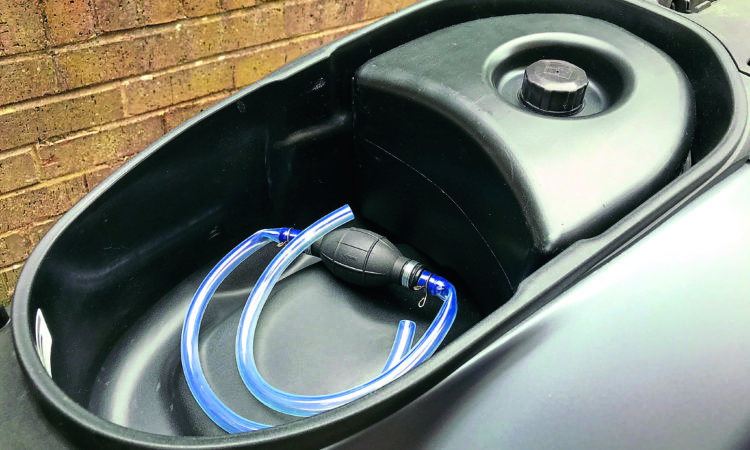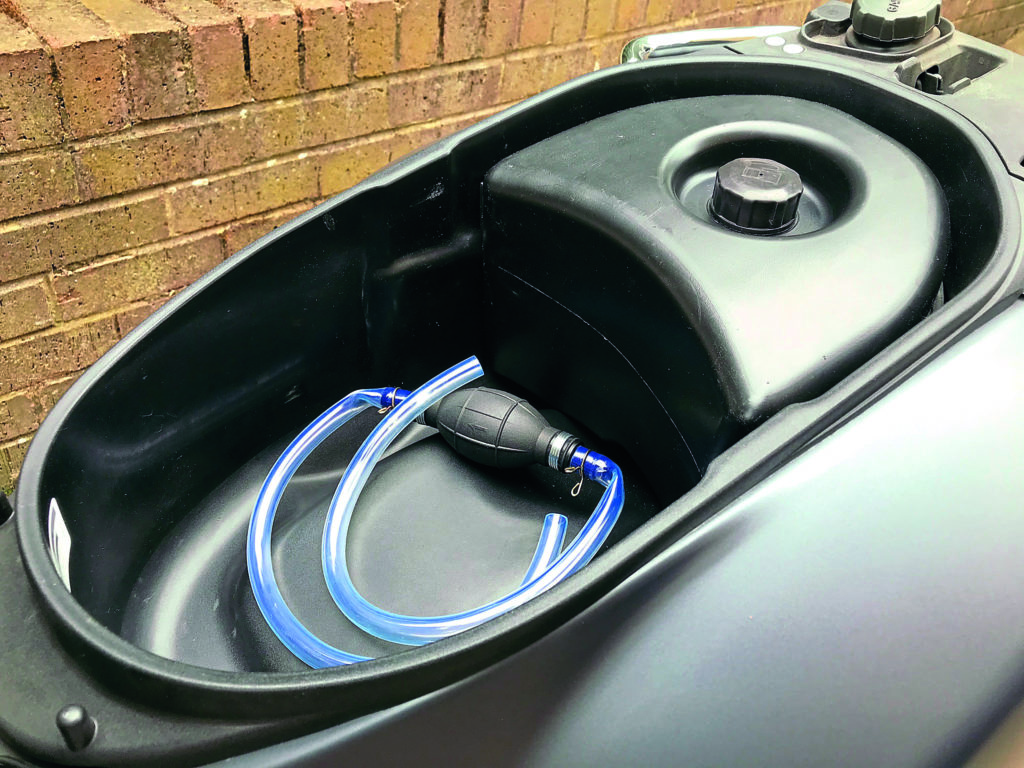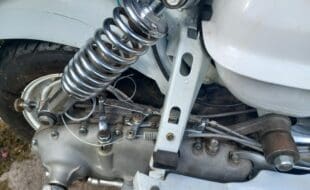We’re a little bit bored of Stan going on about the GTS’s lack of fuel capacity, so this ‘auxiliary tank’ is the chance for him to put his money where his mouth is.
“My name is Stan and I suffer from fuel anxiety.” There, I’ve said it. It doesn’t matter if I’m on the PX, GP or GTS – I’ve a constant nagging inside me that I’m going to run out of fuel. That’s mainly because I’m so bad at fuel management that I’m either refuelling every 50 miles or running dry. That’s why I rarely go anywhere without an extra litre of petrol strapped somewhere to the scooter.
My nervousness is worse on the GTS, the HPE has a smaller tank than the older versions and my typical range is around 85 miles. In fairness that’s about the same as my two-strokes but because I cover a lot of motorway miles on the GTS, those 80 miles seem to go by very quickly.
Enjoy more Scootering reading in the monthly magazine.
Click here to subscribe & save.
In the past I’ve carried a one-litre canister under the seat but that’s not vented and although I’d release pressure every time I filled up, in my heart I know that’s a bad idea. One of my GTS riding chums brought this device to my attention and I’ve now travelled around 2000 miles with it under my seat. Here’s what I’ve made of it so far.
Q. What is it?
It’s a five-litre plastic fuel container specifically designed to fit in the storage tub of a Vespa GTS.
Q. How much does it cost?
Frankly, not cheap. They’re sold on ‘direct from factory’ far eastern websites, typically retailing at between £55 and £75 plus carriage.
Q. How does it work?
Seriously? Okay, it has an opening that fits standard fuel nozzles. Transfer from this to the main tank is by a bulb pump that’s supplied with the kit.
Q. Is it legal?
That’s a better question. It’s a ‘fuel container’, not a ‘fuel tank’ and surprisingly there’s no defined standard for a fuel container. Fortunately there is some guidance produced by the Health and Safety Executive. (if you’re bored: https://www.hse.gov.uk/fireandexplosion/portabable-petrol-storage-containers.pdf). Looking at the main points, here’s how the GTS container shapes up:
- ‘Has a nominal capacity no greater than 10 litres if made of plastic’. Yes
- ‘Is made of either metal or plastic (of a type) that is suitable and safe for the purpose’: I’ve no idea, neither the web listing nor the canister states what it’s made from.
- ‘Be designed and constructed so that they are reasonably robust and not liable to break under the normal conditions of use’: So far so good.
- ‘The escape of liquid or vapour is prevented’: No. There’s a definite smell of fuel under the seat and even moderately enthusiastic riding will find petrol escaping from the vent hole and pooling around the filler.
- ‘Petrol can be poured safely from them’: The pump is a brilliant piece of kit. Pouring is a different matter as there’s no handle and the container is difficult to grip. Again, no.
- ‘Is not unsteady when placed on a flat surface’: It rocks a bit so, no.
- Be marked or labelled in a legible and indelible form with – 1. ‘the words PETROL and HIGHLY FLAMMABLE, an appropriate hazard warning sign and the nominal capacity in litres’: No, none of the above – though I could get a sticker from eBay. 2. ‘ the manufacturer’s name and the date and month of manufacture’: No.
Technically the container’s legal, because there’s nothing to make it illegal, but things aren’t stacking up well for it so far.
Q. Isn’t it hot under a GTS’s seat?
Yes it is, but I’ve ridden around with a thermometer in the tub for a while and recorded temperatures of around 35C. Although that’s not somewhere I’d store a chicken sandwich, for large parts of the world that’s ambient riding temperature. The main risk is with fuel vapour expanding and not being able to escape. Unfortunately this container seems to compensate by being over-vented.
Most people who comment on the dangers posed by the temperature under a GTS’s seat fail to appreciate that the standard fuel tank is plastic and fitted in the engine compartment. Conversely most people who say that the standard fuel tank is plastic and fitted in the engine compartment fail to appreciate that Piaggio went to a lot of time, trouble and money to make sure that its plastic tank is safe. I’m not sure how much effort went into testing this one.
Q. Have you needed to use it?
Yes, it’s saved me on a couple of occasions. Once when, characteristically, I miscalculated and ran out of fuel on the M1 and secondly when panic buying erupted in Milton Keynes. It’s also silenced the nagging voice in my head that says I’ll run out of fuel soon.
Q. Do you recommend it?
I know of two others who are trying one this year. If we haven’t all erupted in a ball of flame by Christmas then we can mark the test as a success. For now I’d say that although I love the concept I’m not at all convinced about its execution.
Words and images: Stan

Enjoy more Scootering reading in the monthly magazine. Click here to subscribe.
Scooter Trader







